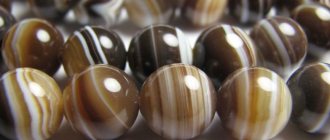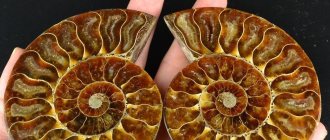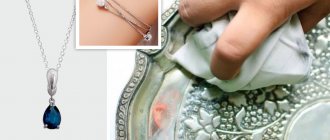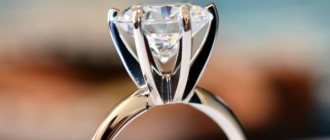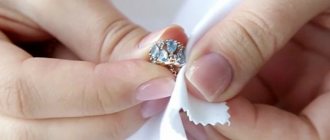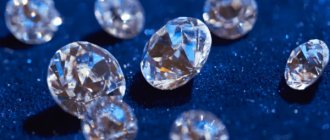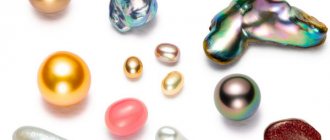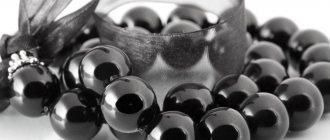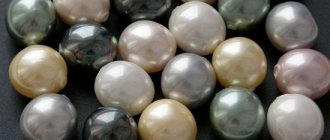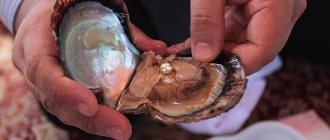The “grain of sand” explanation is a myth
Pearls are real anomalies in the world of jewelry stones. Not only do they themselves come from a living organism (mollusk), but they also take their characteristic pearly iridescence from an organic substance - mother of pearl. In addition, pearls emerge from their shells as a “finished product”, without requiring cutting or other post-finishing processing (except when a corresponding fashionable trend appears - note JEWELERUM).
The origin of a pearl in a mollusk is usually explained by the “grain of sand theory.” It is believed that layers of mother-of-pearl envelop a grain of sand that accidentally fell inside a shell containing a mollusk. However, experts dispel this myth. A more plausible “suspect” is a microscopic organism that moves inside the fleshy part of the mollusk shell and forces the nacre to “respond to the invader” by enveloping the irritant in a special secretion. Over time, a pearl grows in this place.
Fact 5: Pearls are the only gemstone that is extracted from living organisms
Pearls are formed in the shells of mollusks. / Photo: Zen.yandex.ru
Pearls are the fruit of the vital activity of living beings. Its formation is a protective reaction of the mollusk to a foreign body that has entered the mantle. Although classified as a precious stone, pearls are significantly different from other specimens that form in the earth's crust when magma cools under pressure.
How did Cleopatra’s famous “pearl” banquet actually take place?
One of the most impressive stories from the world of pearls has always been considered the legend of a dinner at which the queen spectacularly won an argument with her husband Mark Antony. The subject of the dispute was the cost of the dinner: Cleopatra assured that she could arrange the most expensive banquet in the history of all time.
Writer and renowned pearl expert Fred Ward provides the following details of the story.
In his book Pearls, the author claims that the queen wanted to impress Antony and the entire Roman Empire, which he represented, with the wealth that Egypt possessed. In her ingenious attempt to do this, Cleopatra removed a large pearl from her earrings, and dissolved it in a glass of wine (according to another version - vinegar), after which she took a sip. Shocked, Antony refused his share of the dinner - a drink with a pearl from the second earring - and acknowledged Cleopatra's victory.
The author supplements the legend with an estimate of the cost of pearls from Pliny, who is often called the first gemologist in human history. Pliny estimated that both pearls were worth 60 million sestres at that time, or approximately $28.5 million in today's dollars.
His Majesty!
For a long time, not a single royal wedding was complete without pearls. Monarchs and nobles used pearls to decorate their ceremonial clothes. There was even such a concept - “power pearl” (pearls as an element of the style of power).
At the baptism ceremony of her son Louis XIII, Marie de Medici was present in a dress embroidered with pearls. It took 30,000 beads to decorate it!
A famous fan of mother-of-pearl earrings was Cleopatra, and necklaces were Queen Elizabeth I. The latter wore 7 strands of beads with pearls.
Did you know that...
The largest pearl in the world is the Philippine “Pearl of Allah”. Her weight is about 6.3 kilograms!
Natural pearls are known by different names such as Oriental, Persian Gulf, and Basra
Around 2,000 years ago, the best examples of pearls were found in the waters of the Persian Gulf, which caused the growth of the pearl business in the regions of Bahrain, Qatar and Basra, through which there were trade routes to Iraq.
In the early 20th century, the depletion of the pearl shellfish population in the gulf and the advance of cultured pearls essentially ended the trade. Today, the terms "Oriental" pearls, Gulf pearls or Basra pearls are used interchangeably, equally denoting natural pearls from the most legendary oyster sources.
The authors of the book People and Pearls: The Magic Endures, Ki Hackney and Diana Edkins, believe that of the world's total pearl reserves, only 0.5% can be considered completely natural. That is why when a natural pearl necklace appears at auction and its estimate reaches $9 million, as happened with a seven-row necklace made of pearls and diamonds in 2013 in Geneva (Christie's), it is literally a piece of history rescued from old storage.
In the photo: a necklace made of 614 natural pearls, sold at a November auction in 2013, photo by Christie's:
Non-ideal forms
There are no two perfectly round and symmetrical pearls. Each one is unique in its own way.
There are 8 shapes of pearls: button, drop, pear, oval, semicircle, circle, irregular shape (baroque or baroque pearl) and sphere. The latter are more valuable than regular round ones, precisely because of their bizarre shape.
A rare type of baroque pearl - Paragon pearls. In appearance they resemble various parts of the human body, silhouettes of animals.
The warm ocean waters are worth thanking for the shine and silkiness of the luxurious South Sea pearls
The author of the article came to this conclusion after a detailed conversation with representatives of the GIA (Gemological Institute of America, note JEWELERUM) Dona Dirlam and Robert Weldon. According to them, South Sea pearls, which are considered the largest and most valuable of the mother-of-pearl varieties, boast such pronounced characteristics of luster and silkiness precisely due to the high temperature of the water of the South Pacific Ocean. Warm ocean currents accelerate the growth of nacre, and the depth of its shining layers is responsible for the famous iridescent effect we see in pearls from these regions.
Who is suitable according to their zodiac sign?
There is no need to be afraid of confusion with astrological compatibility. The stone was discovered a long time ago, and astrology did not appear today. This means that experts had a lot of time to study the influence of the stone on the zodiac signs.
Who is it suitable for:
- Cancer and Pisces. Pearls and these zodiac signs belong to the same element - water. But don't be fooled. This harmonious union can also cause harm. Too frequent contact with the talisman will turn Cancers and Pisces into hypersensitive individuals.
- Taurus . But with this sign it’s the other way around. The stone will quickly pacify the restive temperament of the stubborn Taurus and teach him to get along with loved ones.
- Aquarius . This sign will also receive its portion of peace from the sea amulet.
There are also signs for whom the stone is not suitable at all. The first candidate for incompatibility is Leo . All because the elements of fire and the elements of water are at enmity with each other, oppressing each other. Therefore, the king of beasts cannot expect any benefit from the water talisman. If Leo begins to wear this stone often, his usual successes in his career will quickly turn into failures. for Sagittarius and Aries for the same reason. Gemini and Capricorn not to buy items with pearls .
Conch and melo pearls: porcelain instead of mother-of-pearl
Conch (conk) and Melo (melo) are two of the rarest and most valuable types of pearls, most radically different from all other pearls produced by bivalve “pearl oyster” shells. Conch and melo pearls are formed not from mother-of-pearl, but from a material that resembles expensive porcelain in appearance. Such pearls are called “non-pearl” (the rarity and high cost of these types is also determined by the fact that conch and chalk pearls cannot be cultivated - note JEWELERUM).
Conch pearls grow in the Caribbean waters near the Bahamas. They are born by Strombus gigas, or the Queen Conch shell, a single-valves (as opposed to bivalve pearl mussels) mollusk that produces pearls of a natural pink color with areas resembling flashes of flame. At the same time, Melo pearls are the product of another sea creature - the huge sea snail Melo melo sea snail, whose habitat is the Andaman and South China Seas. Their best specimens are distinguished by their orange color, reminiscent of ripe papaya.
Pictured: Conch pearl bracelet with enamel and diamonds, Cartier, late 1920s, sold for $3,461,147 at Sotheby's Geneva in November 2012, setting a record price for a piece of conch pearl (photo: Sothebys. com)
Fact 7: Pearl tribute was collected in ancient China
Chinese Emperor Yu introduced pearl tribute. / Photo: Harvardmagazine.com
In ancient China, it was believed that pearls fell from heaven (and, apparently, fell directly into the hands of the rulers and their entourage). It was not only a symbol of wisdom, but also one of the most beloved stones of emperors. There is an opinion that the name of the mineral comes from the Chinese “zhen-gzhu”.
In China, pearls have always been an attribute of power and high status. A pearl attached to a headdress symbolized the high position of its owner. And the Chinese Emperor Yu considered the precious material the most valuable offering, which is why he introduced pearl tribute in the state. The mineral even managed to play the role of currency: in Ancient China it was customary to pay for the most expensive and large purchases.
Pearls benefit the body
Kokichi Mokimoto is the son of a noodle maker from Toba, Japan. It was he who invented the method of culturing pearls in 1893, and was able to promote pearls using new technology throughout the world. And it was he who believed that pearls bring longevity. According to the book Men and Pearls: Magical Trials, he ate two pearls for breakfast throughout his life, and died in 1954, when he was 96 years old. Bon appetit!)
Read the entire article in English.
Help: where are pearls mined?
The regions where pearls are found have one common characteristic: they are all located in the tropics or subtropical climate zones, whose year-round natural conditions are best conducive to the growth of pearls.
Today there are 11 known pearl zones:
- Persian Gulf
- Gulf of Mannar (Mannar gulf) in the Indian Ocean off Sri Lanka
- Red sea
- coasts and islands of southeast Asia and India
- northern and northwestern coast of Australia
- central and southern Pacific Islands (French Polynesia, Fiji, Cook Islands and Philippines)
- coasts and islands of East Africa
- southern coasts of China and Japan
- coasts and islands of Venezuela and the Caribbean
- coasts and islands of Panama
- coasts and islands of California
More information about the types and evaluation of pearls: massilia-diamant.fr/pearls__9_.html
A good illustrated overview of types of pearls: jewelerymag.ru/p/pearls-types
About pearls in our guide to jewelry stones | Pearl beads and necklaces made of sea and river pearls
| Pearl jewelry from 189 rubles in Moscow and St. Petersburg, free delivery throughout Russia. |
Precious freshwater pearls are formed in shells of the unionidae family, or pearl-like ones.
Of these, the most important are mollusks of two genera - Margaritana and Dahurinaia. Among the margaritans, the supplier of freshwater pearls is the freshwater pearl mussel (Margaritana margaritifera). It lives in the rivers of the Baltic States, Karelia, the Kola Peninsula, Finland, Sweden, Norway, England, Ireland, North America, and is found at the mouth of the Don and in the cascades of the Pyrenees. Until recently, the mollusk was quite widespread. Its rapid disappearance in a number of areas is explained not only by predatory extermination in the pursuit of pearls, but also by the severe swampiness of river banks, the influx of swamp water into them, the development of timber rafting, and the presence in the water of disturbed mineral particles that clog the gills of the margaritana. Margaritana lives in clean flowing rivers and streams with slowly flowing cold water containing a minimal amount of calcium and magnesium salts. There should be no more than 15 mg/l of lime in it. The bottom is composed of fine sand, granites, gneisses, and crystalline schists; coastal vegetation provides good shade. The largest accumulations of shells are observed in places where the direction of the flow turns. The depth of margaritana habitats ranges from 0.4-1 m on the rapids to 2.4 m on the reaches. The range of the pearl mussel in the North-West of the USSR is limited to rivers devoid of lime and coincides with the range of trout. Margaritana, having settled in the river, greatly contributes to the fact that the water becomes clean. It constantly pumps water through itself, retaining turbidity and nutrients. This is how the shell feeds.
The mollusk has a strong, thick-walled oval or kidney-shaped shell, up to 12 cm long, similar in appearance to an ordinary river toothless shell, only larger and covered on the inside with beautiful mother-of-pearl. Mother of pearl is white with a slight bluish tint. The annual growth of the shell is 1.63 mm. In winter, the shell grows 4 times slower than in summer. This circumstance causes the formation of special growth rings on the shell, similar to those that form on the scales of fish. By the number of these rings one can judge their age: many animals live up to 80-90 years. Margaritana is a sedentary colonial animal. It moves with the help of a developed ax-shaped leg: it will put it between the doors, burrow into the sand and pull up the entire house. So, in a day it can walk up to half a meter.
Each female pearl mussel produces up to 3 million eggs [Graevsky, Baranov, 1949]. The pearl oyster keeps its eggs between the valves until they turn into glochidia larvae, which are able to move independently. After this, the larvae with a current of water enter the gills of salmon fish (salmon, trout, pink salmon), where they become parasites for some time. Fish absorb oxygen dissolved in water; With water, tiny nutrient particles also enter through the gills. Fish carry larvae over long distances, thus colonizing new areas of water bodies. Over time, the larvae turn into miniature shells. They fall to the bottom and begin to lead a new life.
In a colony on the ground, dark margaritana shells stand vertically, slightly tilted with the current. They are located so closely that they resemble a kind of pavement. Biologists B.F. Golubev and A.B. Esipov [1973] write that in the Emesh River (Kola Peninsula) there are areas with a saturation of mollusks of up to 500 specimens per 1 square meter.
The pearl mussel is widespread in the Keret River in the North-West of the USSR. It flows through rocky soil and wetlands, there are many rapids and reaches. The total reserves of pearl mussels in the river are 4.5 million specimens [Golubev, Esipov, 1973]. Shells were found along a third of the river, starting from the Krivoe rapids. They are located in dense colonies, mainly in rapids, where the number of shells reaches 50 specimens per 1 square meter. In calmer sections of the river, the density of colonies decreases to 10 specimens per 1 square meter. The Varzuga River, one of the main waterways of the Kola Peninsula, is richest in pearl mussels. Shells were found on an area of about 10 million square meters. Data on freshwater pearl mussel stocks in the rivers of the North-West of the USSR are given in the table compiled based on materials from Golubev and Esipov [1973].
The table shows that the total and commercial reserves of freshwater pearl mussels in the water bodies of the North-West of the USSR are quite large, and almost half a century ago they were estimated at only 3 million individuals.
| River | Pool | Reserves, million copies | |
| Are common | Commercial | ||
|
|
|
|
|
|
|
|
|
|
| |
|
|
|
|
|
|
|
|
|
|
|
|
|
|
|
|
|
|
| |
Two species of mollusks belonging to the genus Daurinaia are of commercial importance: the Daurian pearl mussel (Dahurinaia dahurica) and the Kamchatka pearl mussel (Dahurinaia midden-dorfii). The Kamchatka pearl mussel is found on the Okhotsk coast of Kamchatka, in mountain and semi-mountain rivers with clean, oxygen-rich water. The areas where it lives are protected from the direct impact of the jet. The oval shell of this pearl mussel reaches a length of 9 cm or more, is characterized by a significant thickness of the valves and a thick mother-of-pearl layer.
The Daurian pearl mussel is widespread throughout the Amur basin (except for the upper and middle reaches of the Amguni River). Inhabits mountain and semi-mountain rivers with sandy and rocky soil and clean, oxygenated water. The length of the mollusk shell is 18 cm, weight 300 g.
The number and distribution of species depend on the purity and temperature of the water, its oxygen content, and the nature of the soil. Pollution and changes in river regimes significantly reduce the number of mollusks, often leading to their complete disappearance. Deforestation and timber rafting, which leads to the accumulation of sunken logs in rivers and their subsequent decomposition, have a negative effect on pearl mussel colonies.
Freshwater, Dahurian and Kamchatka pearl mussels are listed in the Red Book of the RSFSR. Among other unionids, high-quality pearls are extracted from the shells of the species Quadrula undulata, Q. plicata, and Plagiola securis.
| Pearl jewelry from 189 rubles in Moscow and St. Petersburg, free delivery throughout Russia. |
